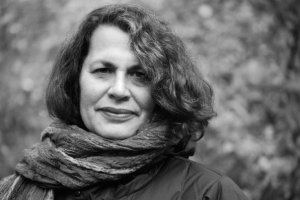DAISY CUTTER
Pause here at the flower stand-mums
and gladiolas, purple carnations
dark as my heart. We are engaged
in a war, and I want to drag home
any distraction I can carry. Tonight
children will wake to bouquets of fire
that will take their breath away. Still,
I think of my life. The way you hold me,
sometimes, you could choke me.
There is no way to protect myself,
except by some brilliant defense. I want
the black iris with their sabered blooms.
I want the flame throwers: the peonies,
the sunflowers. I will cut down the beautiful ones
and let their nectared sweetness bleed
into the careless air. This is not the world
I’d hoped it could be. It is horrible,
the way we carry on. Last night, you catalogued
our arsenal. You taught me devastation
is a goal we announce in a celebration
of shrapnel. Our bombs shower
in anticipation of their marks. You said this
is to assure damage will be widely distributed.
What gruesome genius invents our brutal hearts?
When you touch me I am a stalk of green panic
and desire. Wait here while I decide which
of these sprigs of blossoming heartbreak I can afford
to bring into my home. Tonight dreams will erupt
in chaotic buds of flame. This is the world we have
arranged. It is horrible, this way we carry on.
-Camille T. Dungy
“Daisy Cutter” in Washington D.C. Poets Against the War, 2nd ed., reprinted on From the Fishouse. Forthcoming July 2011 in Smith Blue (Southern Illinois University Press), winner of the 2010 Crab Orchard Open Prize.
Used by permission.
 Camille T. Dungy is author of Suck on the Marrow (Red Hen Press, 2010), What to Eat, What to Drink, What to Leave for Poison (Red Hen Press, 2006), and Smith Blue, winner of the 2010 Crab Orchard Open Prize (forthcoming from Southern Illinois University Press, 2011). She is editor of Black Nature: Four Centuries of African American Nature Poetry (UGA, 2009), and co-editor of From the Fishouse: An Anthology of Poems that Sing, Rhyme, Resound, Syncopate, Alliterate, and Just Plain Sound Great (Persea, 2009). Dungy has received fellowships from organizations including the National Endowment for the Arts, the Virginia Commission for the Arts, Cave Canem, and Bread Loaf. She is associate professor of Creative Writing at San Francisco State University. Dungy’s poems have recently appeared in print and online journals including, American Poetry Review, Poetry Daily, Drunken Boat, Verse Daily,and Electronic Poetry Review.
Camille T. Dungy is author of Suck on the Marrow (Red Hen Press, 2010), What to Eat, What to Drink, What to Leave for Poison (Red Hen Press, 2006), and Smith Blue, winner of the 2010 Crab Orchard Open Prize (forthcoming from Southern Illinois University Press, 2011). She is editor of Black Nature: Four Centuries of African American Nature Poetry (UGA, 2009), and co-editor of From the Fishouse: An Anthology of Poems that Sing, Rhyme, Resound, Syncopate, Alliterate, and Just Plain Sound Great (Persea, 2009). Dungy has received fellowships from organizations including the National Endowment for the Arts, the Virginia Commission for the Arts, Cave Canem, and Bread Loaf. She is associate professor of Creative Writing at San Francisco State University. Dungy’s poems have recently appeared in print and online journals including, American Poetry Review, Poetry Daily, Drunken Boat, Verse Daily,and Electronic Poetry Review.









